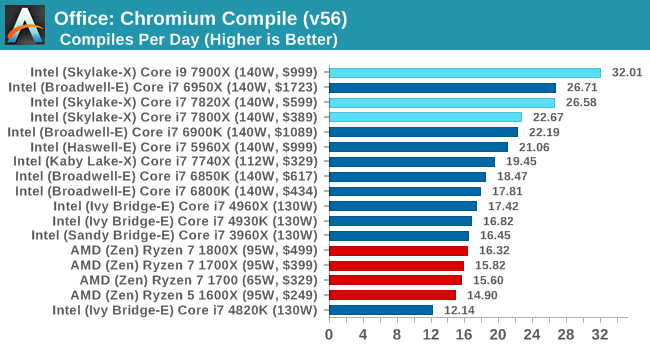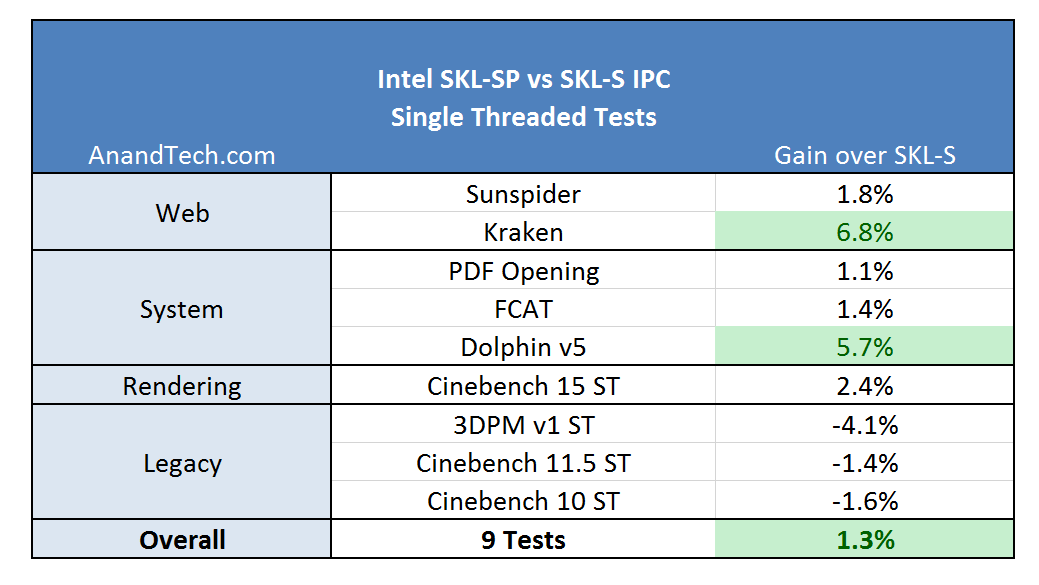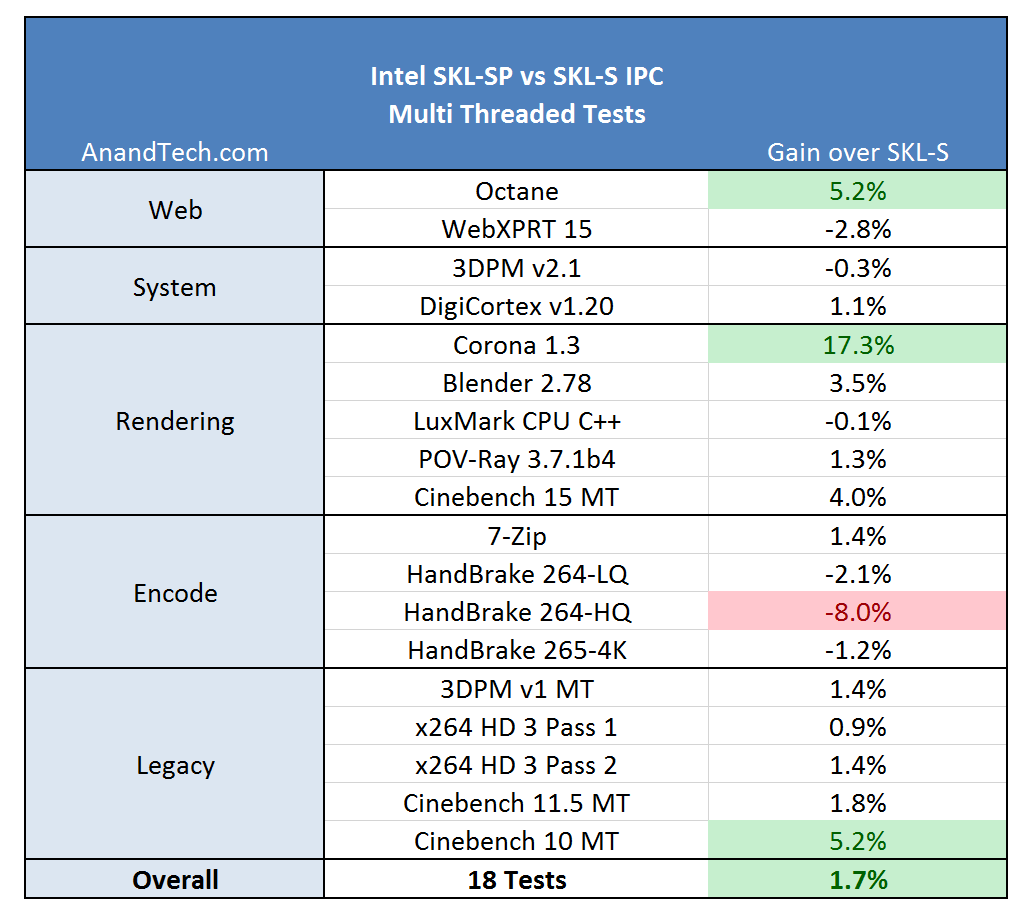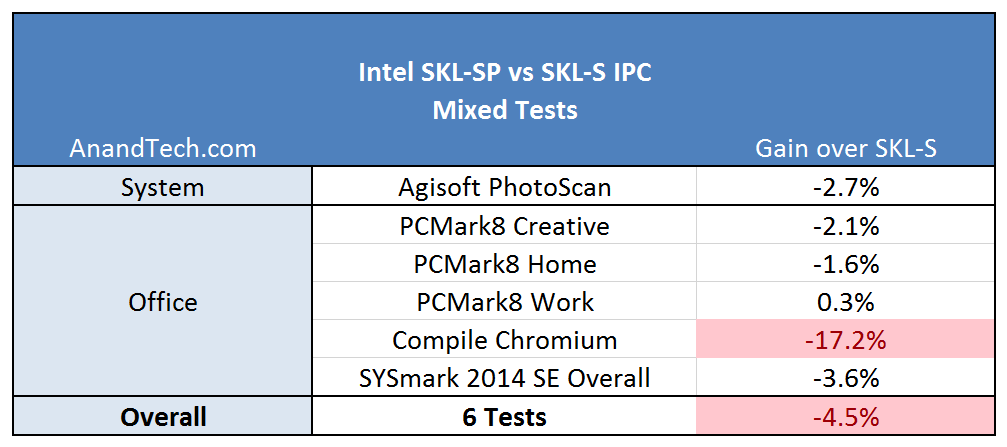The Intel Skylake-X Review: Core i9 7900X, i7 7820X and i7 7800X Tested
by Ian Cutress on June 19, 2017 9:01 AM ESTComparing Skylake-S and Skylake-X/SP Performance Clock-for-Clock
If you’ve read through the full review up to this point (and kudos), there should be three things that stick in the back of your mind about the new Skylake-SP cores: Cache, Mesh and AVX512. These are the three main features that separate the consumer grade Skylake-S core from this new core, and all three can have an impact in clock-for-clock performance. Even though the Skylake-S and the Skylake-SP are not competing in the same markets, it is still poignant to gather how much the changes affect the regular benchmark suite.
For this test, we took the Skylake-S based Core i5-6600 and the Skylake-SP based Core i9-7900X and ran them both with only 4 cores, no hyperthreading, and 3 GHz on all cores with no Turbo active. Both CPUs were run in high performance modes in the OS to restrict any time-to-idle, so it is worth noting here that we are not measuring power. This is just raw throughput.
Both of these cores support different DRAM frequencies, however: the i5-6600 lists DDR4-2133 as its maximum supported frequency, whereas the i9-7900X will run at DDR4-2400 at 2DPC. I queried a few colleagues as to what I should do here – technically the memory support is an extended element of the microarchitecture, and the caches/uncore/untile will be running at different frequencies, so how much of the system support should be chipped away for parity. The general consensus was to test with the supported frequencies, given this is how the parts ship.
For this analysis, each test was broken down in two ways: what sort of benchmark (single thread, multi-thread, mixed) and what category of benchmark (web, office, encode).
For the single threaded tests, results were generally positive. Kraken enjoyed the L2, and Dolphin emulation had a good gain as well. The legacy tests did not fair that great: 3DPM v1 has false sharing, which is likely taking a hit due to the increased L2 latency.
On the multithreaded tests, the big winner here was Corona. Corona is a high-performance renderer for Autodesk 3ds Max, showing that the larger L2 does a good job with its code base. The step back was in Handbrake – our testing does not implement any AVX512 code, but the L3 victim cache might be at play here over the L3 inclusive cache in SKL-S.
The mixed results are surprising: these tests vary with ST and MT parts to their computation, some being cache sensitive as well. The big outlier here is the compile test, indicating that the Skylake-SP might not be (clock for clock) a great compilation core. This is a result we can trace back to the L3 again, being a smaller non-inclusive cache. In our results database, we can see similar results when comparing a Ryzen 7 1700X, an 8-core 95W CPU with 16MB of L3 victim cache, is easily beaten by a Core i7-7700T, with 4 cores at 35W but has 8MB of inclusive L3 cache.
If we treat each of these tests with equal weighting, the overall result will offer a +0.5% gain to the new Skylake-SP core, which is with the margin of error. Nothing too much to be concerned about for most users (except perhaps people who compile all day), although again, these two cores are not in chips that directly compete. The 10-core SKL-SP chip still does the business on compiling:

If all these changes (minus AVX512) offer a +0.5% gain over the standard Skylake-S core, then one question worth asking is what was the point? The answer is usually simple, and I suspect involves scaling (moving to chips with more cores), but also customer related. Intel’s big money comes from the enterprise, and no doubt some of Intel’s internal metrics (as well as customer requests) point to a sizeable chunk of enterprise compute being L2 size limited. I’ll be looking forward to Johan’s review on the enterprise side when the time comes.













264 Comments
View All Comments
mat9v - Tuesday, June 20, 2017 - link
To play it safe, invest in the Core i9-7900X today.To play it safe and get a big GPU, save $400 and invest in the Core i7-7820X today.
Then the conclusion should have been - wait for fixed platform. I'm not even suggesting choosing Ryzen as it performs slower but encouraging buying flawed (for now) platform?
mat9v - Tuesday, June 20, 2017 - link
Please then correct tables on 1st page comparing Ryzen and 7820X and 7800X to state that Intel has 24 lines as they leave 24 for PCIEx slots and 4 is reserved for DMI 3.0If you strip Ryzen lines to only show those available for PCIEx do so for Intel too.
Ryan Smith - Wednesday, June 21, 2017 - link
The tables are correct. The i7 7800 series have 28 PCIe lanes from the CPU for general use, and another 4 DMI lanes for the chipset.PeterCordes - Tuesday, June 20, 2017 - link
Nice article, thanks for the details on the microarchitectural changes, especially to execution units and cache. This explains memory bandwidth vs. working-set size results I observed a couple months ago on Google Compute Engine's Skylake-Xeon VMs with ~55MB of L3: The L2-L3 transition was well beyond 256kB. I had assumed Intel wouldn't use a different L3 cache design for SKX vs. SKL, but large L2 doesn't make much sense with an inclusive L3 of 2 or 2.5MB per core.Anyway, some corrections for page3: The allocation queue (IDQ) is in Skylake-S is always 64 uops, with or without HT. For example, I looked at the `lsd.uops` performance counter in a loop with 97 uops on my i7-6700k. For 97 billion counts of uops_issued.any, I got exactly 0 counts of lsd.uops, with the system otherwise idle. (And I looked at cpu_clk_unhalted.one_thread_active to make sure it was really operating in non-HT mode the majority of the time it was executing.) Also, IIRC, Intel's optimization manual explicitly states that the IDQ is always 64 entries in Skylake.
The scheduler (aka RS or Reservation Station) is 97 unfused-domain uops in Skylake, up from 60 in Haswell. The 180int / 168fp numbers you give are the int / fp register-file sizes. They are sized more like the ROB (224 fused-domain uops, up from 192 in Haswell), not the scheduler, since like the ROB, they have to hold onto values until retirement, not just until execution. See also http://blog.stuffedcow.net/2013/05/measuring-rob-c... for when the PRF size vs. the ROB is the limit on the out-of-order window. See also http://www.realworldtech.com/haswell-cpu/6/ for a nice block diagram of the whole pipeline.
SKL-S DIVPS *latency* is 11 cycles, not 3. The *throughput* is one per 3 cycles for 128-bit vectors, or one per 5 cycles for 256b vectors, according to Agner Fog's table. I forget if I've tested that myself. So are you saying that SKL-SP has one per 5 cycle throughput for 128-bit vectors? What's the throughput for 256b and 512b vectors?
-----
It's really confusing the way you keep saying "AVX unit" or "AVX-512 unit" when I think you mean "512b FMA unit". It sounds like vector-integer, shuffle, and pretty much everything other than FMA will have true 512b execution units. If that's correct, then video codecs like x264/x265 should run the same on LCC vs. HCC silicon (other than differences in mesh interconnect latency), because they're integer-only, not using any vector-FP multiply/add/FMA.
-------
> This should allow programmers to separate control flow from data flow...
SIMD conditional operations without AVX512 are already done branchlessly (I think that's what you mean by separate from control-flow) by masking the input and/or output. e.g. to conditionally add some elements of a vector, AND the input with a vector of all-one or all-zero elements (as produced by CMPPS or PGMPEQD, for example). Adding all-zeros is a no-op (the additive identity).
Mask registers and support for doing it as part of another operation makes it much more efficient, potentially making it a win to vectorize things that otherwise wouldn't be. But it's not a new capability; you can do the same thing with boolean vectors and SSE/AVX VPBLENDVPS.
PeterCordes - Tuesday, June 20, 2017 - link
Speed Shift / Hardware P-State is not Windows-specific, but this article kind of reads as if it is.Your article doesn't mention any other OSes, so nothing it says is actually wrong: I'm sure it did require Intel's collaboration with MS to get support into Win10. The bullet-point in the image that says "Collaboration between Intel and Microsoft specifically for W10 + Skylake" may be going too far, though. That definitely implies that it only works on Win10, which is incorrect.
Linux has supported it for a while. "HWP enabled" in your kernel log means the kernel has handed off P-state selection to the hardware. (Since Linux is open-source, Intel contributed most of the code for this through the regular channels, like they do for lots of other drivers.)
dmesg | grep intel_pstate
[ 1.040265] intel_pstate: Intel P-state driver initializing
[ 1.040924] intel_pstate: HWP enabled
The hardware exposes a knob that controls the tradeoff between power and performance, called Energy Performance Preference or EPP. Len Brown@Intel's Linux patch notes give a pretty good description of it (and how it's different from a similar knob for controlling turbo usage in previous uarches), as well as describing how to use it from Linux. https://patchwork.kernel.org/patch/9723427/.
# CPU features related to HWP, on an i7-6700k running Linux 4.11 on bare metal
fgrep -m1 flags /proc/cpuinfo | grep -o 'hwp[_a-z]*'
hwp
hwp_notify
hwp_act_window
hwp_epp
I find the simplest way to see what speed your cores are running is to just `grep MHz /proc/cpuinfo`. (It does accurately reflect the current situation; Linux finds out what the hardware is actually doing).
IDK about OS X support, but I assume Apple has got it sorted out by now, almost 2 years after SKL launch.
Arbie - Wednesday, June 21, 2017 - link
There are folks for whom every last compute cycle really matters to their job. They have to buy the technical best. If that's Intel, so be it.For those dealing more with 'want' than 'need', a lot of this debate misses an important fact. The only reason Intel is suddenly vomiting cores, defecating feature sizes, and pre-announcing more lakes than Wisonsin is... AMD. Despite its chronic financial weakness that company has, incredibly, come from waaaay behind and given us real competition again. In this ultra-high stakes investment game, can they do that twice? Maybe not. And Intel has shown us what to expect if they have no competitor. In this limited-supplier market it's not just about who has the hottest product - it's also about whom we should reward with our money, and about keeping vital players in the game.
I suggest - if you can, buy AMD. They have earned our support and it's in our best interests to do so. I've always gone with Intel but have lately come to see this bigger picture. It motivated me to buy an 1800X and I will also buy Vega.
Rabnor - Wednesday, June 21, 2017 - link
To play it safe and get a big GPU, save $400 and invest in the Core i7-7820X today.You have to spend that $400+ on a good motherboard & aio cooler.
Are you sold by Intel, anandtech?
Synviks - Thursday, June 22, 2017 - link
For some extra comparison: running Cinebench R15 on my 14c 2.7ghz Haswell Xeon, with turbo to 3ghz on all cores, my score is 2010.Pretty impressive performance gain if they can shave off 4 cores and end up with higher performance.
Pri - Thursday, June 22, 2017 - link
On the first page you wrote this:Similarly, the 6-core Core i7-7820X at $599 goes up against the 8-core $499 Ryzen 7 1800X.
The Core i7 7820X was mistakenly written as a 6-core processor when it is in-fact an 8-core processor.
Kind Regards.
Gigabytes - Thursday, June 22, 2017 - link
Okay, here is what I learned from this article. Gaming performance sucks and you will be able to cook a pizza inside your case. Did I miss anything?Oh, one thing missing.
Play it SMART and wait to see the Ripper in action before buy your new Intel toaster oven.